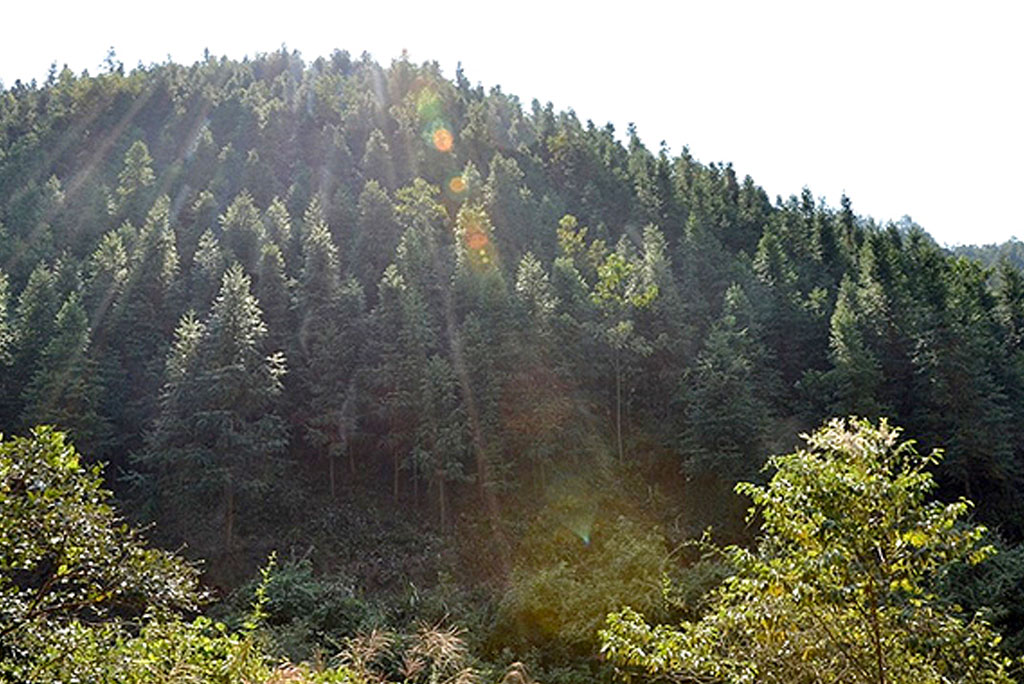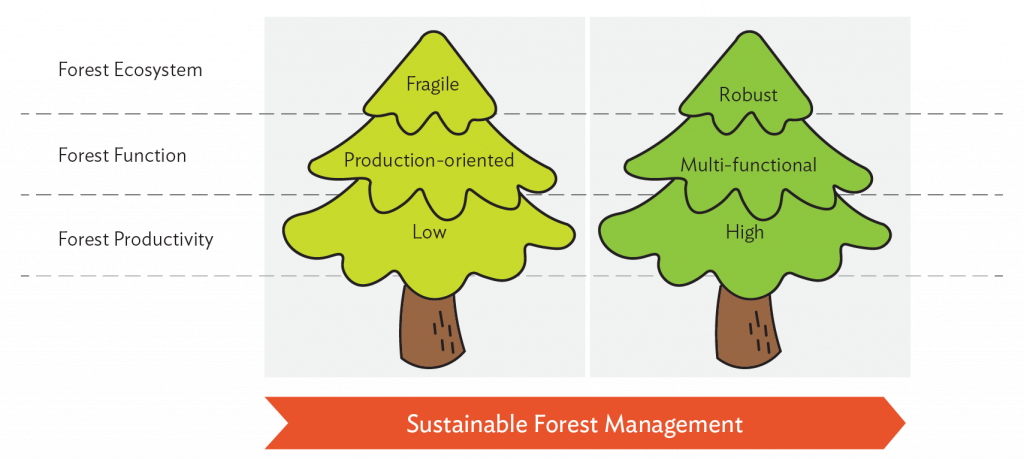East Asia Blog Series
Balancing Ecological and Economic Development through Sustainable Forest Management
Xin Shen 21 Nov 2020
Jiangxi province in the People’s Republic of China enhances forest productivity and ecosystem health using holistic and sustainable practices.
Overview
Forestry plays an important role in both economic development and environmental sustainability. For Jiangxi, a mountainous province in the People’s Republic of China (PRC), the forestry sector is one of the key drivers of growth as it provides protection and livelihood to rural communities. However, overexploitation of natural forests, underutilization of forestlands, inappropriate tree species selection, unbalanced stands structure, and unsustainable silviculture practices have made the province’s forest ecosystem fragile.
With the growing demand for forest products, the forestry sector of Jiangxi requires significant improvement to satisfy the economic needs of the province while rehabilitating the degraded forest ecosystem. A project funded by the Asian Development Bank (ADB) introduced sustainable forest management to help Jiangxi improve the health of its forest ecosystem and enhance its economic potential.
Project information
42022-013: China, People’s Republic of – Jiangxi Sustainable Forest Ecosystem Development Project
Project snapshot
- Approval date: 9 November 2010
- Closing date: 30 July 2018
- Total project cost: $70 million
- Executing agency: Jiangxi Provincial Government
- Financing: Asian Development Bank, Government and Beneficiaries
Context
Jiangxi is a mountainous and underdeveloped province in the southeastern part of the country. In 2008, its provincial gross domestic product (GDP) per capita was only CNY14,727 (about $2,000), one-third less than the national average.
Mountainous and hilly areas account for 78% of the province’s total area. In 2008, the forestry sector’s gross output reached CNY76 billion or 14% of the provincial GDP. In the same year, its forestlands contributed to 7% and 8% of the PRC’s wood and bamboo production. Forests logs are mainly used as sawn timber, veneer, and fiberboard for domestic uses.
Development Challenges
About 10.6 million ha or 62.5% of Jiangxi’s total area is designated as forestland. However, 1.5 million ha of these lands were barren or low yielding. The average forest stock volume was only 34.4 cubic meters (m3) per ha, much lower than both the national average of 76 m3/ha and the world average of 99.8 m3/ha.
Jiangxi’s forest ecosystem was fragile due to its unbalanced age and the monoculture structure of its young and middle-aged stands and unsustainable silviculture practices. Major causes include:
- the historical overexploitation of forest resources,
- the underutilization of forestlands because of lack of investment and/or access to credit,
- short-sighted production-oriented afforestation,
- inadequate know-how or skill in forest management by the communities, and
- lack of institutional experience in sustainable forest management.
The forests are also vulnerable to natural disasters, such as the winter storms that hit the PRC in 2008. The underutilization of forestland had led to soil erosion, siltation of rivers and lakes, and deterioration of water quality.
Rapid economic growth has escalated the country’s demand for forest products. The government needs to move away from production-orientated, low-quality monoculture forest development to meet the rising demand of wood-processing industries, improve the health of the forest ecosystem, and boost carbon sequestration to mitigate climate change.
Solution
Approved by ADB in 2010, the Jiangxi Sustainable Forest Ecosystem Development Project helped establish new forest plantations, rehabilitated barren and low-yielding forestlands, and promoted sustainable forest management through an ecosystem-based, multi-functional forest development approach.
Sustainable forest management is a strategy that contributes to the management, conservation, and sustainable development of forests and provides for their multiple and complementary functions and uses to meet the social, economic, ecological, cultural, and spiritual needs of present and future generations. The project adopted a holistic approach which takes ecological, silvicultural management, and social aspects into account following the sustainable forest management principles.
The project also enhanced the local capacity and reinforced environmental protection awareness among stakeholders through intensive trainings on sustainable forest management, forest carbon sequestration and stock estimation, and climate disaster risk mitigation. It also provided forest insurance against natural risks and set up a system to monitor forest carbon stock.
Following the sustainable forest management principles, new design rules and environmental codes were prepared by the project to guide participating counties and end-borrowers through site selection, design, implementation, and inspection. A total of 47,638 ha of forestlands were developed or rehabilitated. Timber plantation (Chinese fir and slash pine), tree crops (orange, oil tea, and tea trees), and low-yielding and snowstorm-damaged bamboo rehabilitation were supported by the project loan to offer options to farmers to balance short-term and long-term incomes when they plan for forest investment. Mixture of broadleaf species with conifers and bamboo groves were introduced to protect forests against climate-related disasters, pests, disease, and fires. Natural regeneration is also protected. Mixed forest is promoted versus monoculture to improve ecological biodiversity and multiply the functions of timber plantation. Farmers adopted environmentally friendly silviculture practices from site preparation to tending.
A forestry insurance program was established to protect the forestry sector from risks. With government subsidy, nearly 30,000 ha of timber plantation was covered by a forest insurance policy to improve the risk resilience of forest farmers, enterprises, and farms. The premium for timber forests is 0.4% of the costs to replant the trees per mu (unit of land measurement in the PRC). Forest insurance and risk mitigation measures training for farmers were also conducted.
Taking advantage of the reform on forest tenure and the development of trading centers for forestry property rights in the PRC, the project accepted forest property and forestland tenure rights as collateral among other collateral and guarantees. This flexible approach effectively enhanced accessibility to credit, and addressed a longstanding issue within the agriculture and forestry sectors about the lack of investment resulting from insufficient collateral or guarantee.
Results
The productivity of the project forests improved with an average yield resembling Jiangxi’s first-rate or top 10% forests. Tea-seed oil yields increased from 225 kilograms per hectare (kg/ha) to 531 kg/ha, orange yields reached 22,612 kg/ha, while tea leaf yields reached 3,088 kg/ha.
Figure 1. Benefits of Sustainable Forest Management

Source: Asian Development Bank
The project promoted environmentally sound practices and generated significant environmental benefits. Bare mountains and slopes were converted into ecologically stable forest stands. Mixed forest plantations improved the structure of the forest, which enhanced resistance to pests and fire, increased biodiversity, and boosted water and soil conservation. Timely rehabilitation of snowstorm-damaged bamboo forests protected them against climate-related disasters, pests, and diseases. Water conservation reached 18 million m3 and soil erosion declined by about 95,300 tons annually. The application of integrated pest management and bio-agents further prevented pollution and outbreaks of pests and diseases. The project also reduced the use of chemical fertilizers by 3.2 million kg per year and replaced them with organic compost and compounds. The project is estimated to contribute about 142,900 tons in carbon sequestration annually.
The intensive training and extension programs improved the local communities’ understanding of and skills in sustainable forest management. The sustainable forest management concept and approach were institutionalized within Jiangxi forestation administration system.
The project also provided 75,368 local farmers and individuals, two-thirds of whom are women, with job opportunities like land preparation, tree planting, forest tending, daily maintenance, and harvesting. Nearly 12,000 households who participated in afforestation and bamboo rehabilitation have improved incomes through profit sharing in farmers’ cooperatives or companies. About 25,000 households have earned incomes by leasing their forestland for annual rents. The high demand for nursery stock, fertilizer, and forestry equipment also contributed to increased rural incomes and reduced poverty in the project area. From 2011 to 2018, rural income grew from 95.9% to 205.7% and poverty incidence rates in project areas declined from 24%–34% to 0.25%–4.71%.
Lessons
Practices that are effective in balancing the ecological and economic development of forestlands include:
- planning for long-term management with clear and defined development objectives;
- using short- to medium-term incomes from economic trees and crops to supplement long-term, multi-purpose timber forest investment;
- replacing monoculture with mixed stands to reduce biotic and abiotic calamities and improve biodiversity;
- integrating existing natural regeneration in the structure of new stands;
- selecting site-adapted, native tree species for afforestation;
- promoting advanced seedling technology and
- paying close attention to the seedling quality;
- shifting to low-impact site preparation and planting techniques;
- applying selective weeding and tending methods; and
- applying tested practical and effective forestry techniques.
A comprehensive quality management mechanism for this project was established with specific indicators and third-party investigation to ensure high quality and productivity of the forestlands. The project’s achievement has attracted farmers’ attention and influenced silviculture activities beyond the project area. The project management office installed signboards on exemplary sites for publicity and to set examples.
Increased financing support from both the public and private sectors allowed for the effective utilization of forestland and further improved the quality of afforestation. In the medium and long-term, this enhances forest production, environmental benefits, and livelihoods.
Overall, it is possible to satisfy the social and economic development needs while balancing ecological and economic development.
References
Author

Xin Shen
Senior Project Officer (Natural Resources and Agriculture), East Asia Department, ADB
This blog is reproduced from Development Asia.


